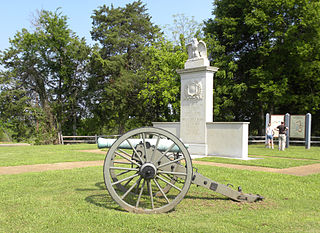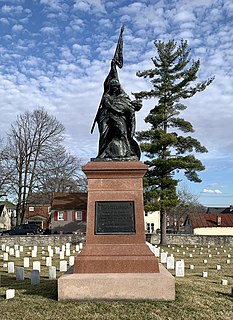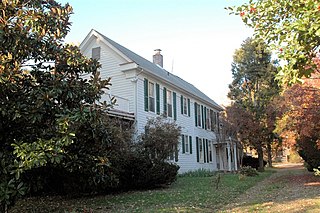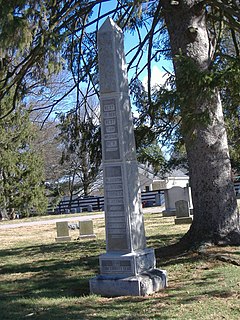
Mount Jackson is a town in Shenandoah County, Virginia, United States. The population was 1,994 at the 2010 census.

Marmet is a city in Kanawha County, West Virginia, United States, along the Kanawha River. The population was 1,503 at the 2010 census.

Saltville is a town in Smyth and Washington counties in the U.S. state of Virginia. The population was 2,077 at the 2010 census. It is part of the Kingsport–Bristol (TN)–Bristol (VA) Metropolitan Statistical Area, which is a component of the Johnson City–Kingsport–Bristol, TN-VA Combined Statistical Area – commonly known as the "Tri-Cities" region.

Hollywood Cemetery is a large, sprawling cemetery located next to Richmond, Virginia's Oregon Hill neighborhood at 412 South Cherry Street. Characterized by rolling hills and winding paths overlooking the James River, it is the resting place of two United States Presidents, James Monroe and John Tyler, as well as the only Confederate States President, Jefferson Davis. It is also the resting place of 28 Confederate generals, more than any other cemetery in the country; these include George Pickett and J.E.B. Stuart.

Brices Cross Roads National Battlefield Site commemorates the Battle of Brices Crossroads, in which the Confederate army, under Major-General Nathan Bedford Forrest, defeated a much larger Union force on June 10, 1864, to ultimately secure supply lines between Nashville and Chattanooga, Tennessee.
Burlington is a census-designated place (CDP) in Mineral County, West Virginia, United States, located along U.S. Route 50 where it crosses Pattersons Creek. As of the 2010 census, its population was 182. It is part of the Cumberland, MD-WV Metropolitan Statistical Area. The ZIP code for Burlington is 26710.

Ebenezer is a historic town in New South Wales, Australia, in the local government area of the City of Hawkesbury. Ebenezer is located 69 kilometres north-west of Sydney and about 5 kilometres from the larger centre of Wilberforce. It sits on the banks of the Hawkesbury River and like typical early 19th century villages in NSW, it straggles along the roads rather than compactly around a village centre.

Winchester National Cemetery is a United States National Cemetery located in the city of Winchester in Frederick County, Virginia. Administered by the United States Department of Veterans Affairs, it encompasses 4.9 acres (2.0 ha), and as of the end of 2005, it had 5,561 interments. It is closed to new interments.
Bloomfield is an unincorporated community in Loudoun County, Virginia. It is situated at the intersection of Airmont and Bloomfield Roads.

Fort Craig was a U.S. Army fort located along El Camino Real de Tierra Adentro, near Elephant Butte Lake State Park and the Rio Grande in Socorro County, New Mexico.

Merrybrook is the only known remaining home of American Civil War Confederate spy Laura Ratcliffe. The house is located south of Herndon, Virginia, in Fairfax County. She lived here from the earliest days of the Civil War until her death in 1923. The interior, out-buildings and grounds still retain the atmosphere of earlier times.

The Martyrs Monument in Midway, located in Midway City Cemetery outside Midway, Kentucky, was placed on the National Register of Historic Places on July 17, 1997, as part of the Civil War Monuments of Kentucky Multiple Property Submission. It honors four Confederate prisoners who were killed due to the standing order of Union General over Kentucky Stephen G. Burbridge, known as Order No. 59, which declared: "Whenever an unarmed Union citizen is murdered, four guerrillas will be selected from the prison and publicly shot to death at the most convenient place near the scene of the outrages." The Confederate prisoners, whose names were M. Jackson, J. Jackson, C. Rissinger, and N. Adams, were executed on November 5, 1864 northeast of Midway, the precise location of which is unknown. This was due to the actions of Sue Mundy, a former trooper under John Hunt Morgan who terrorized Union forces in Kentucky during the later years of the American Civil War. They were buried in shallow graves originally, then re-buried in a Presbyterian cemetery, and finally in 1890 moved to their current location, with the dedication of the Martyrs Monument.

Orlando is an unincorporated community located in Braxton and Lewis counties, West Virginia, United States. It is located on Oil Creek, a tributary of the Little Kanawha River.

Thomas Armstrong Morris was an American railroad executive and civil engineer from Kentucky and a soldier, serving as a brigadier general of the Indiana Militia in service to the Union during the early months of the American Civil War. During the Western Virginia Campaign in 1861, he played an important role in leading regiments from West Virginia, Indiana, and Ohio in clearing the Confederate army from western Virginia during the Battle of Philippi, a move that helped bolster pro-Union sentiment and contributed to the creation of the separate state of West Virginia. Morris was also instrumental in the planning and construction of the postbellum Indiana State House.

Old Brick Church, which is also known as Ebenezer Associate Reformed Presbyterian (ARP) Church or First Associate Reformed Presbyterian Church is a church built in 1788 about 4 mi (6 km) north of Jenkinsville on SC 213 in Fairfield County, South Carolina. It was named to the National Register of Historic Places on August 19, 1971. It is one of the few 18th-century churches surviving in the South Carolina midlands.

Morgan Chapel and Graveyard — also known as Christ Episcopal Church-Bunker Hill — is a historic church in Bunker Hill, Berkeley County, West Virginia. It is the oldest Episcopal church congregation in West Virginia.

Fort Morris Historic Site is a Georgia state historic park in Liberty County, Georgia in the United States. The fort is on a bend in the Medway River and played an important role in the protection of southeast Georgia throughout various conflicts beginning in 1741 and ending in 1865 at the conclusion of the American Civil War, including the French and Indian and American Revolutionary Wars and War of 1812. The historic site is 70 acres (28 ha) and sits at an elevation of 23 feet (7.0 m).

The Landon House, also known as the Stancioff House, is a historic home located at Urbana, Frederick County, Maryland, United States. It was built about 1849 and is a large three-story frame house with a notable clerestory roof, and two-story full length galleried porch. The home's interior woodwork is of a simple Greek Revival style. The former smokehouse has been converted to a chapel. The house is said to have originally stood on the Rappahannock River near Fredericksburg, Virginia, and moved to its present location in 1846 at the direction of the Reverend R.H. Phillips. It has been used as both a school and private home. Reverend Phillips established a Female Seminary here between 1846 and 1850, then become a military institute for boys, and by the end of the 1850s it apparently had resumed its role as a Female Seminary. It was used by the 155th Pennsylvania Volunteers as a resting point for Union Troops marching toward the Battle of Antietam on September 16, 1862. The house would host a cotillion ball for Confederate soldiers before eventually becoming a field hospital during the civil war. During 2013 the building was purchased by new owners who have plans to restore it to its Civil War state.

St. Thomas Chapel, also known as St. Thomas Episcopal Church or St. Thomas Protestant Episcopal Chapel, is a historic building located at 7854 Church Street in Middletown, Frederick County, Virginia, United States. Built in the 1830s, regular services were held at the Episcopal church for almost 100 years. The building has been restored twice, once after being heavily damaged during the Civil War, and again in the 1960s. The church was added to the Virginia Landmarks Register (VLR) and the National Register of Historic Places (NRHP) in 1973.

The Battle of Lewisburg occurred in Greenbrier County, Virginia, on May 23, 1862, during the American Civil War. A Union brigade commanded by Colonel George Crook soundly defeated a larger Confederate force commanded by Brigadier General Henry Heth. Panicked Confederate forces escaped by crossing and burning a bridge across the Greenbrier River.
























